Meet Winslow, who has his own toy piano and knows how to play it.

Winslow’s playing reminds me a bit of Nora, but with a toy piano it brings to mind John Cage’s Suite for Toy Piano, and some of my own composition.

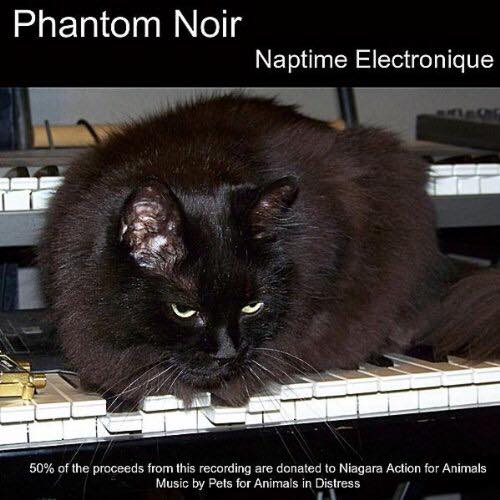
Phantom performs on a Yamaha DX21 synthesizer. From Andreas Gregor via Facebook.
This was Phantom. He had an ear for synthesizers. I recorded him on my DX21 one day. I think he might be the only cat that released a track on iTunes and Amazon. Lol.
The track Naptime Electronique is available on Amazon and Apple Music.
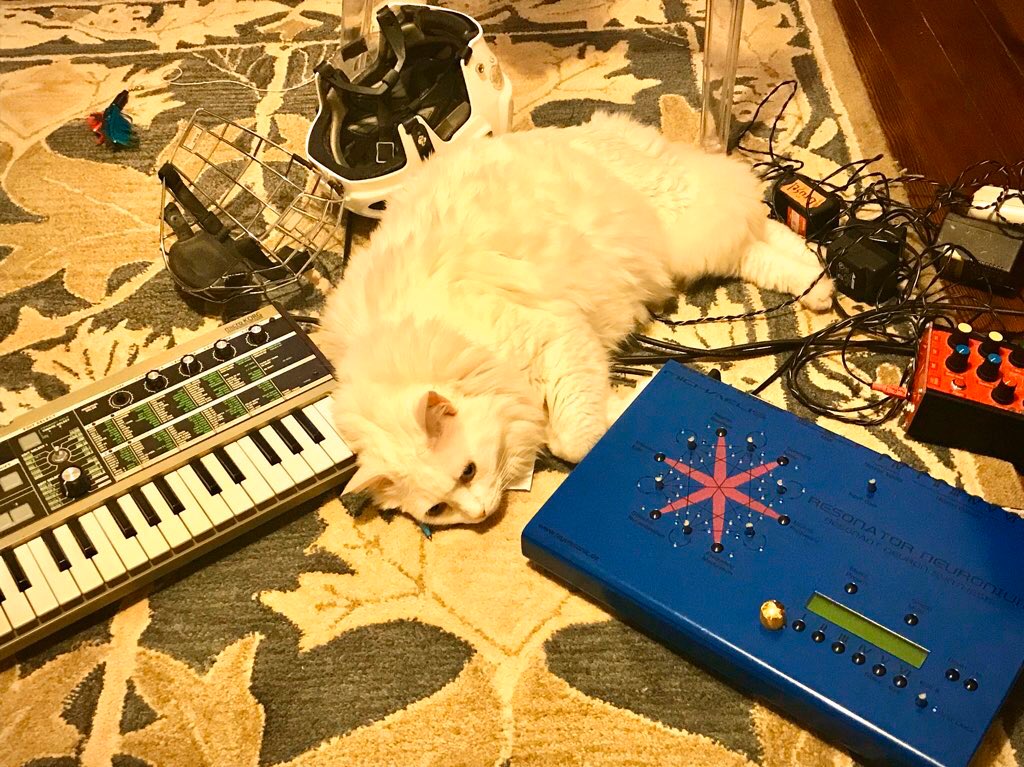
Our friend Merce joins us again, with the Jomox Resonator Neuronium along with the MicroKORG. He also shares this classic Fluxus piano piece by George Brecht.
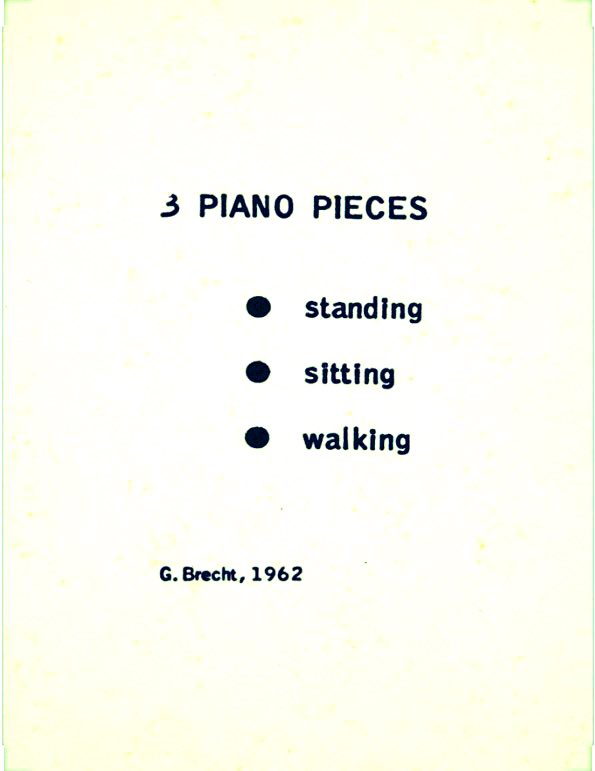
When you can’t even get a Fluxus piece right. George Brecht, “3 Piano Pieces,” from Water Yam, 1962
Even we at CatSynth sometimes find it hard to Fluxus right in these anxious times.
We say goodbye to another musical hero. Manu Dibango passed away today at his home in France, apparently of complications from Covid-19.
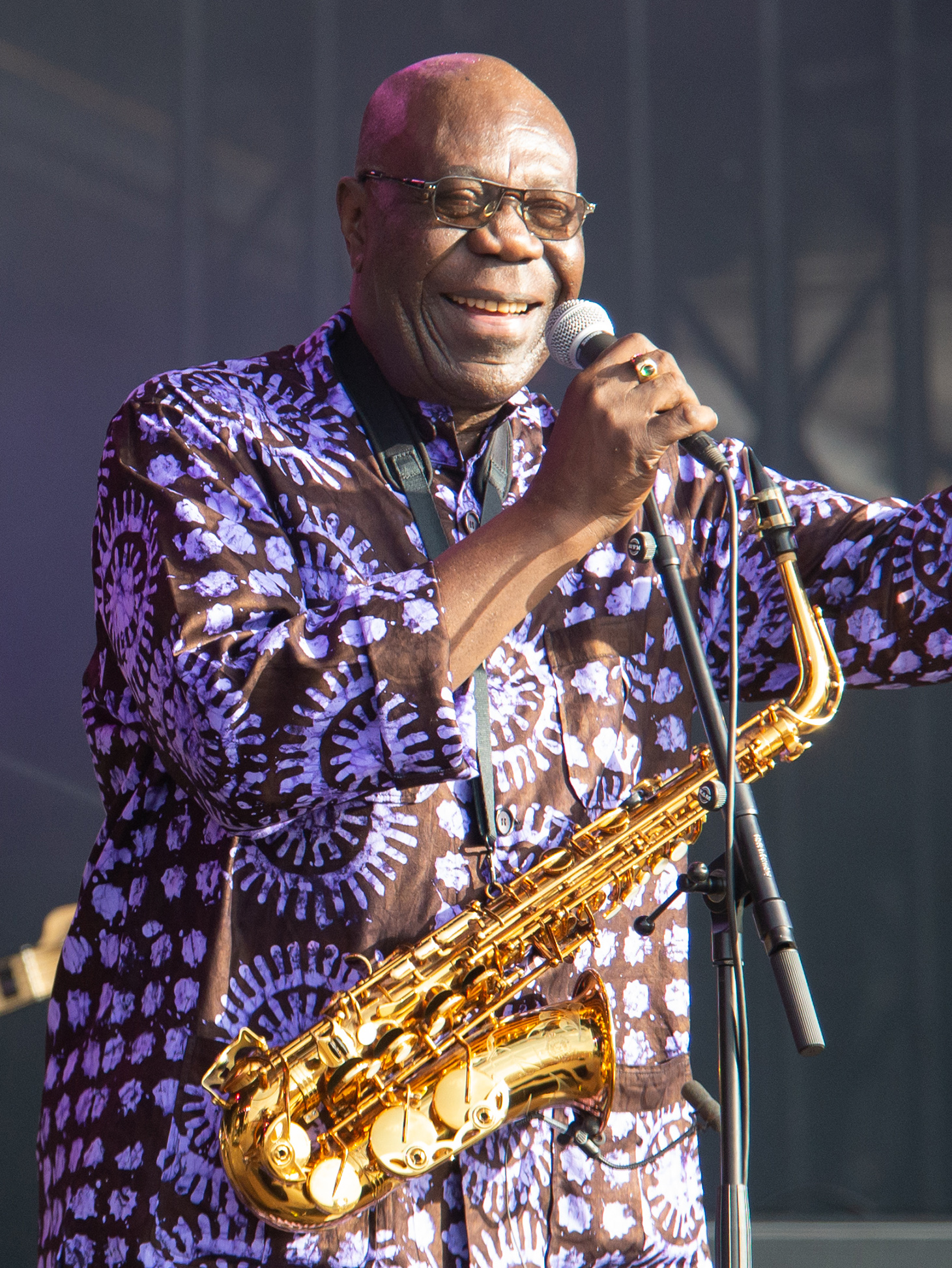
Like many others, I knew Dibango’s music initially through the song “Soul Makossa.” I had heard it on and off over the years, but it was after delving more seriously into the history of 1970s disco in 2010 that I rediscovered the song and its connection to the early disco gatherings of New York including David Mancuso’s Loft parties. It was a B-side of a single that Mancuso found and it became an instant proto-disco hit, and on regular rotation in my own playlist in the early 2010s. It also went on to be a major influence on R&B and funk. It was instantly recognizable with the chat “Soul Makossa”, Dibango’s growling saxophone and catchy horn hook.
Dibango was originally from Cameroon – indeed makossa is a traditional style of Cameroonian music and came up in central Africa’s jazz scene, including African Jazz in Kinshasa, Congo. Over the years he has collaborated with other heroes of ours including Fela Kuti and Herbie Hancock, with whom he recorded the album Electric Africa in the 1980s.
It is jarring to hear of Dibango’s death being so connected to the current crisis, and certainly not the last. His music represents, at least for me, simpler and brighter times, the optimism and nostalgia of the 1970s, and more. RIP.
It’s one of those serendipitous moments that happen in New York. At the end of last week’s Ambient Chaos show, I received an invitation from Neb Ula the Velvet Queen to come to LadyJams is a monthly get-together where women get together and perform in randomly selected groups. I loved the idea, and especially the coincidence of this meeting; so on Friday I grabbed my trusty Arturia MicroFreak and headed out on the L train to Bushwick.
The festivities took place at Synesthesia, a gallery and art space in the apartment of Mio Nakai. Amidst objects and curios from the turn of the 20th century – and an old-fashioned bar to match – was an exhibition of sculptures that evoked both a delicate graceful quality and a confounding misplacement of human forms. It was in the midst of this milieu that Ladyjams unfolded.
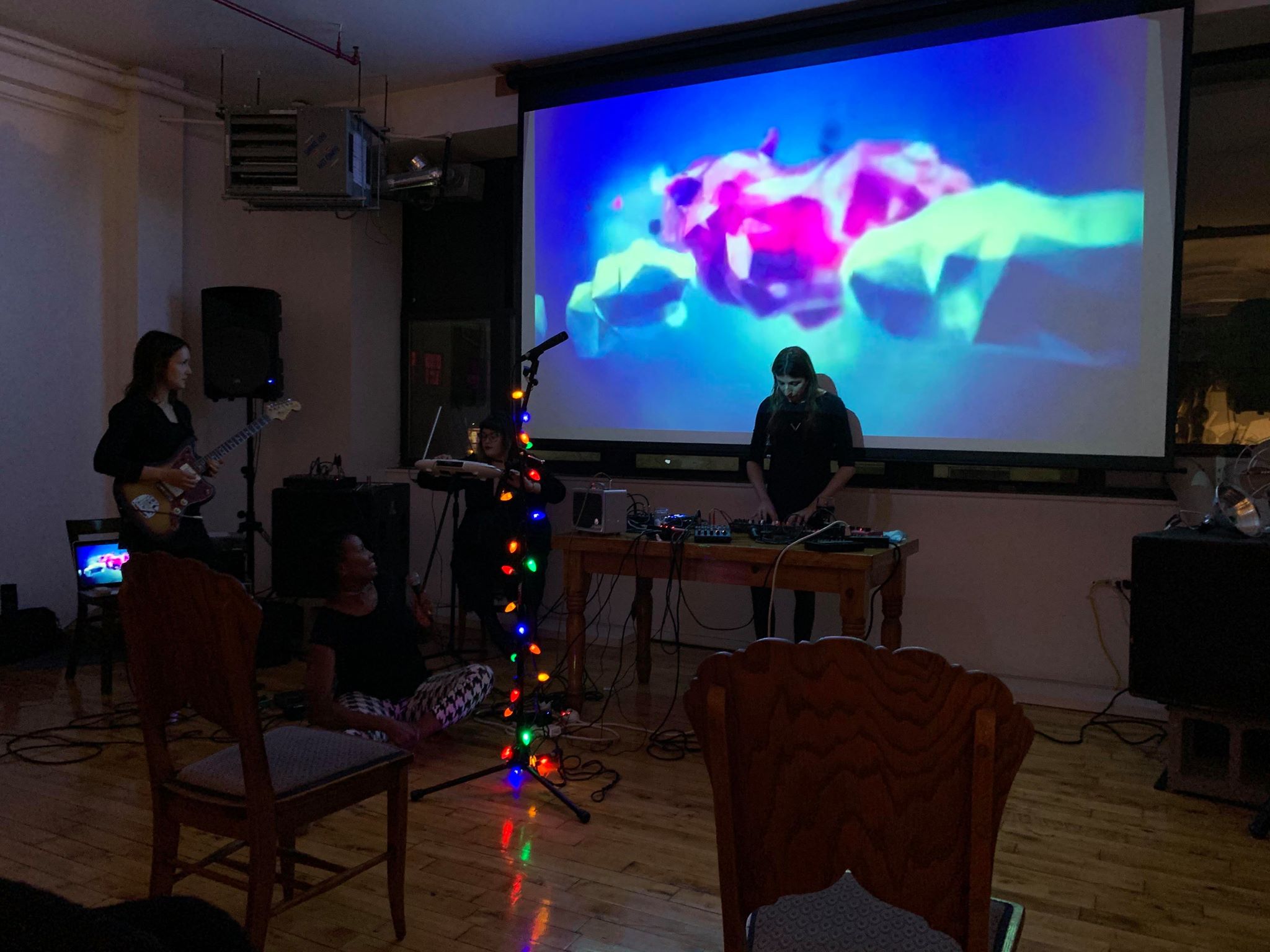
I made some more new friends that evening, including Laura Feathers, Teena Mayzing, and Yana Davydova, who performed on electronics, voice, and guitar, respectively. I performed with them and others over the course of the evening in several miniature improvised sets. You can hear an example in this video.
This truly spur-of-the-moment music, as I had never performed with any of these artists before. The MicroFreak was definitely the right choice of instrument, given its versatility and immediacy (as well as being extremely light). I had some light melodic spacey touches, as well as deep bass pedal tones and various sound effects. I particularly enjoyed a call-and-response with Yana Davydova on guitar – we both were able to match one another’s melodic fragments and respond with variations that moved the performance forward. I also tried to choose sounds and notes to complement the words of Teena Mayzing and others during vocal sections.
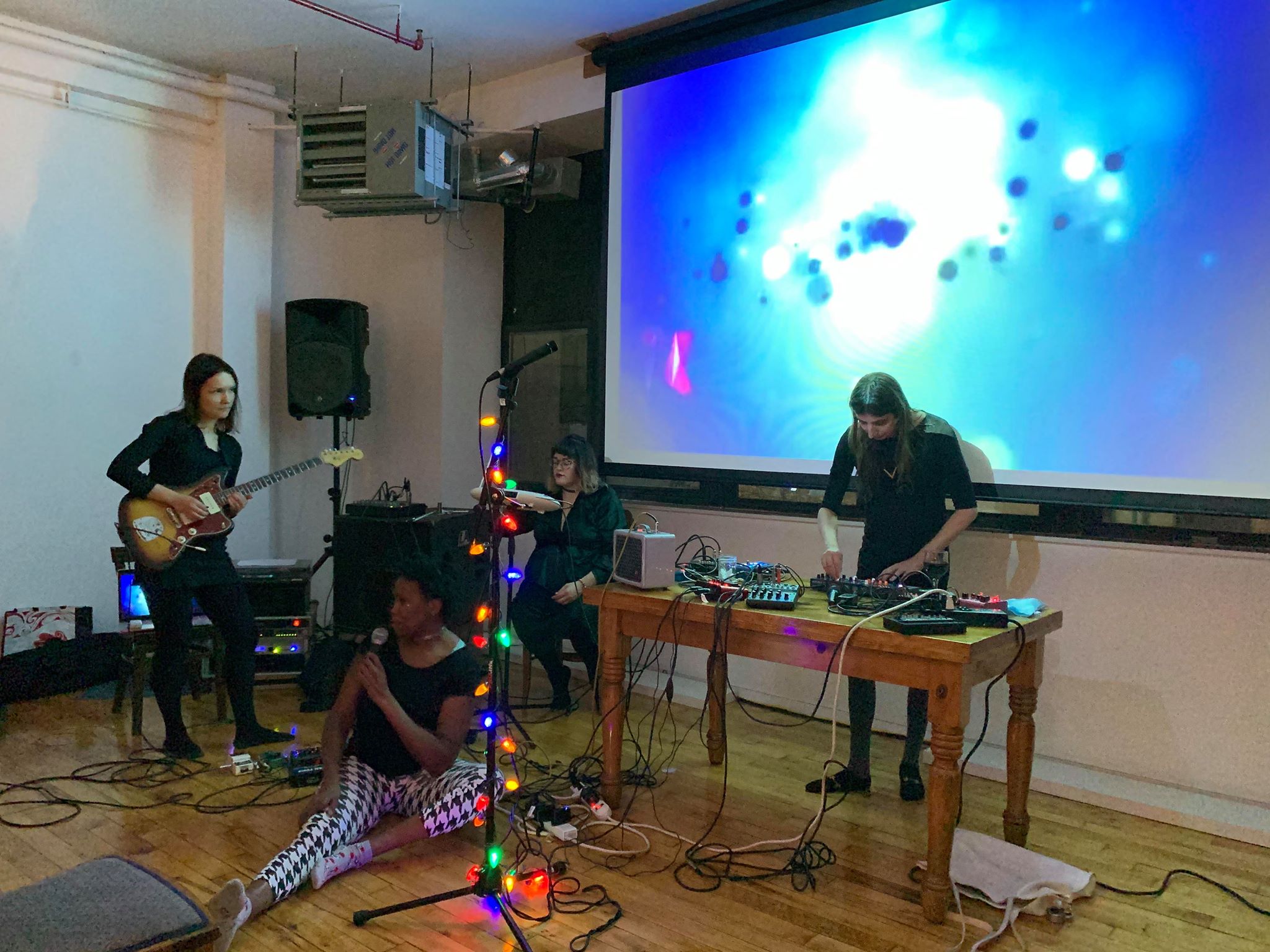
Neb Ula and I also had a chance to perform together, as seen in the photo above and following video clip.
Although New York – and perhaps Brooklyn in particular – is an exceptionally fertile place for an event like this, I am left wondering why not try to do something similar in San Francisco? I certainly know enough women and non-binary performers to make it a possibility, so perhaps it will happen.
It is that time of year when I invariably return home to New York for a visit. And this time it began in dramatic fashion with a return to the Ambient Chaos music series at Spectrum. Perhaps not quite a return, as Spectrum as since moved to a new location on the waterfront in Brooklyn. But it was still the same concept, hosted by Robert L. Pepper of Pas Musique, with a variety of local and visiting musicians performing adventurous electronic music.
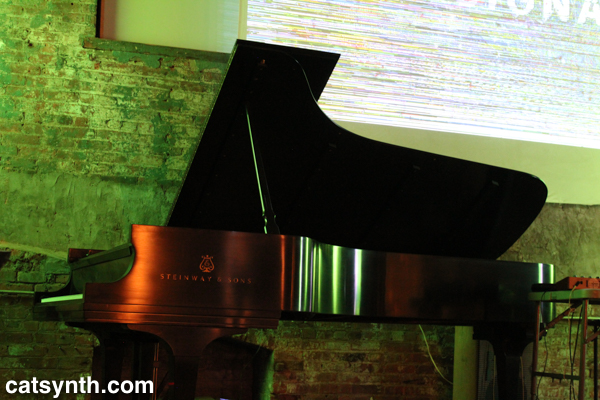
The evening opened with a duo featuring Public Speaking (aka Jason Anthony Harris) and pianist Gabriel Zucker.
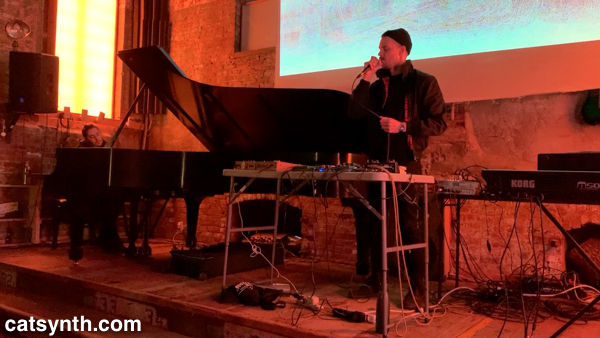
The unfolded in with sparse but structured piano set against electronic sounds evoking metal machinery. Both elements started out slow and quiet with lots of empty space but increasingly got more dense and urgent. After a brief interlude, a new phase of the music began with vocals set against fast piano runs. The vocals began very expressive and plaintive but soon morphed into a complex electronic sound under vocal control. Underneath this, an incessant thudding drum emerged.
Next up was The Tony Curtis Experience, a trio led by Damien Olsen on keyboard and electronics, Jeremy Slater on guitar and electronics, and Neb Ula the Velvet Queen on theremin – specifically, a Moog Theremini with which we at CatSynth are quite familiar.
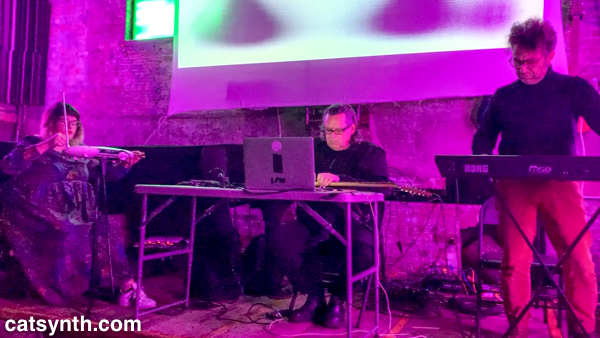
Their performance mixed long tones on theremin, slide guitar + electronics, and synthesizer pads with loud percussive moments. The early portion of the set evoked some fantastic futuristic nightclub with crystalline hits and pedal tones. But Olsen’s keyboard brought it back to the present and near past with melodic and harmonic playing reminiscent of mid-20th century cabaret as well as synth-pop of the 1980s. The theremin, acting as both sound source and controller, provided antiphonal counter-subjects to these familiar sounds; and the guitar drones glued everything together. It was a fun set, especially with Olsen’s playful performance and his use of familiar idioms.
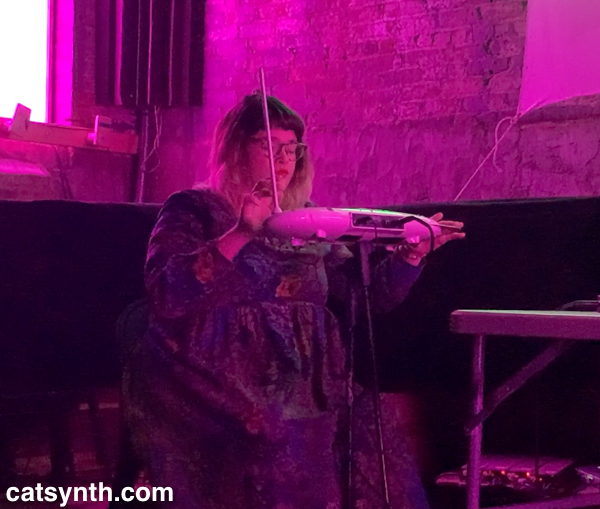
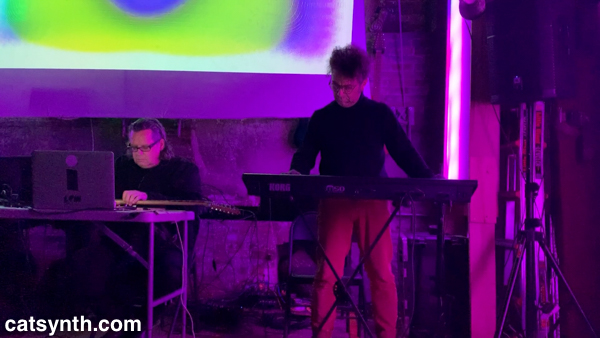
Then it was my turn to take the stage. And I compacted the setup for travel, with the Arturia MicroFreak, laptop, Novation LaunchPad Pro, tiny modular with Qu-bit Prism and Strymon Magneto, a new handmade touch synthesizer, and Crank Sturgeon Pocket Gamelan.
I planned a slimmed-down version of my solo set from the Compton’s Cafeteria Series show in August, including White Wine and an evolving improvisation over an 11/8 groove.
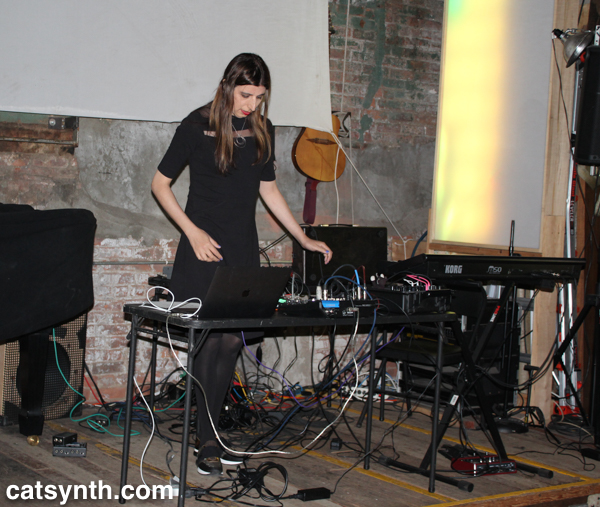
Overall, the set went well – a highly dynamic performance with a lot of melodic elements, jazz riffs, and noise solos layered over rhythms. A few items misfired, but all recoverable. I particularly enjoyed the sections of melody and jazz improvisation where I floated back to the sounds of the 1970s; it seemed the audience appreciated that, too. Finally, it was also just fun to be playing in New York again after an extended break. Watching the video of the set (which will be shared soon as an episode of CatSynth TV), I particularly thought this noisier and more “electronic” version of the 2019 set worked well in Spectrum and especially with the every-changing “spectrum” of light from yellow to violet and everything in between.
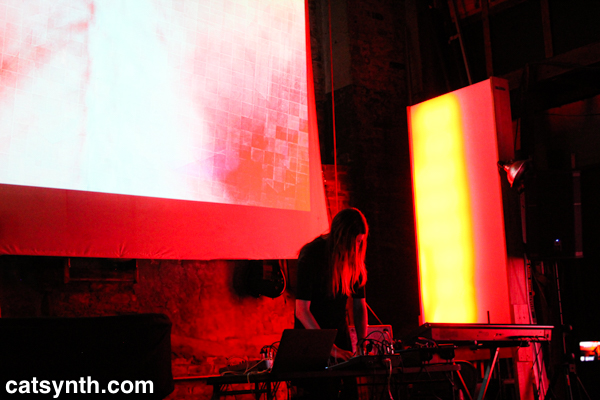
The final set of the evening featured 4 Airports, a duo of guitarist Craig Chin and synthesist Nathan Yeager. Chin performed with guitar and an array of pedals, while Yeager brought a large synthesizer setup complete with a modular system.
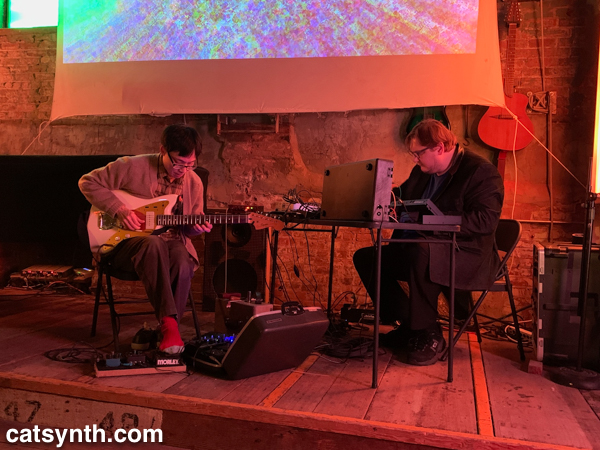
Perhaps more than the preceding sets, they lived up to the “ambient” in Ambient Chaos. Chin’s guitar gestures were subtle as he guided the sound into the electronic arena of the pedals, and Yeager’s synthesizer sounds were complex but still lending themselves to long ideas even when the tones and timbres moved between quick and slow. From the chaotic undertones and singular and dreamy landscape emerged, with occasional ebbs and flows and punctuations.
Overall, it was a wonderful night of music in this corner of the Brooklyn waterfront, with an intimate crowd in the cavernous but cozy space. I would also be remiss if I did not give a shout out to Sofy Yuditskaya for her video projections that reflected the music on stage. I certainly hope the gap until my next performance here is much shorter than the last.
[Photos by Banvir Chaudhary and Amanda Chaudhary]
[Full video coming soon. Please subscribe to CatSynth TV to be noticed when it is available.]
Our incredibly musical two weeks that began with Herbie Hancock concluded with King Crimson’s return to the Fox Theater in Oakland. We at CatSynth saw their last visit in 2017 and were excited to hear what the brought this time around.
It was a pleasure to see King Crimson back in action again, albeit with another lineup change. This time around, Bill Reiflin was not with the group, and so there was no full-time keyboardist. His duties were taken over by drummer Jeremy Stacey, and, at times, winds player Mel Collins. Of course, Robert Fripp was there, holding court seated stage left next to his tower of gear, as were longtime members Tony Levin on bass and Chapman stick and Jakko Jakszyk on lead vocals and guitar. Rounding out the trio of drummers were Gavin Harrison and Pat Mastelotto.
The group once again made a great overview of their 50-year history. I was particularly pleased to hear “Cat Food” from the 1970 album In the Wake of Poseidon played. “Cat Food Cat Food…again!” The music is malleable and adaptable to the current band’s instrumentation and abilities. Choruses are reharmonized, as was the case with “Cat Food”; vocal numbers are re-arranged into extended instrumental pieces, as in “The Construction of Light”; new melodies were added, as in “Indiscipline”; and so on. There were also new lyrics to the chorus of “Easy Money”. The combination of the three drumsets was even tighter than the previous tour, and more nuanced as well with each playing entirely different parts in a three-voice counterpoint that occasionally coalesced into a massive syncopated thunder. It should also be noted that the drums were a bit lighter because of Stacey’s keyboard duties.
The sound in the first set was a bit challenging at times; the winds and vocals in particular suffered. Thankfully, this was all corrected going into the second set. And just when it seemed they were going to get through the entire night without playing “21st Century Schizoid Man”, they returned with the tune as their encore, with extended abstract solos and instrumental sections.
As always, King Crimson is very strict about photography during their concerts, but at the very end, they ritualistically share a moment taking pictures of the audience while we picture them. This time both Tony Levin and Robert Fripp snapped pictures of the audience as we returned the favor.
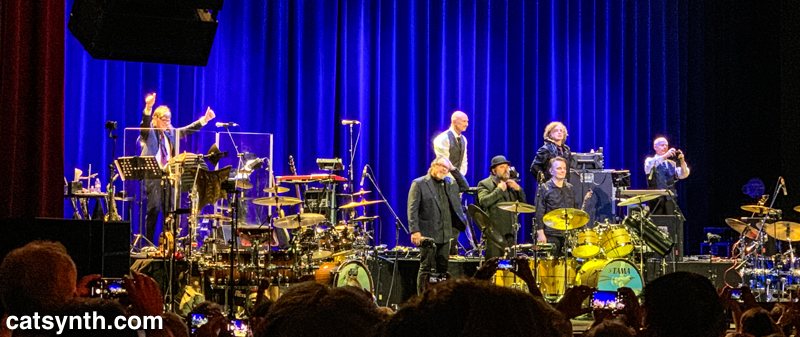
Here is a photo of the audience from Tony Levin’s blog. We are somewhere in the lower left of the orchestra.
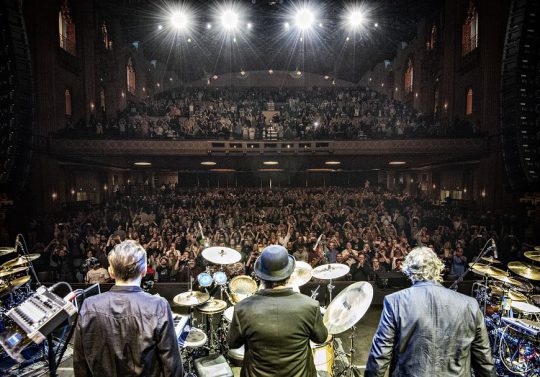
[Jason Berry contributed to this story]
It’s been a wonderfully musical couple of weeks for us at CatSynth. Two days in the recording studio, our recent performance…and all of this bookended by concerts featuring our musical heroes. Today we visit the first of those concerts featuring Herbie Hancock at the Greek Theater in Berkeley.
Those who have been longtime readers of this site or familiar with some of my recent music will recognize the tremendous influence of Herbie Hancock, especially his Mwandishi and Head Hunters bands of the 1970s. For a concert in 2019, I honestly wasn’t sure what to expect. But from the moment the maestro took the stage, I was not disappointed.
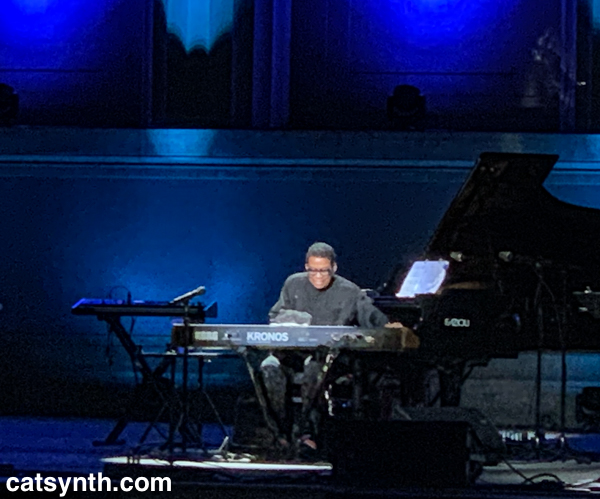
Together with his current band – Vinnie Colaiuta on drums, James Genus on bass, Lionel Loueke on guitar and multi-instrumentalist Terrace Martin on horns and keyboard – he revisited many of the old classics, but with new twists. Some, like Chameleon and Cantelope Island, pretty much followed their classic forms and were a delight. Others, like Butterfly and Sunlight were quoted more subtly or obliquely, teasing us a bit through solos, chord changes, and excursions before landing on the tune’s head just long enough of us to recognize it and use it as a point of departure for the next section. This is something that we have heard Wayne Shorter do in his more recent performances as well – just enough of a hint of the original tune for us to notice before departing into new musical territory. It was pretty much everything I would hope for from this concert.
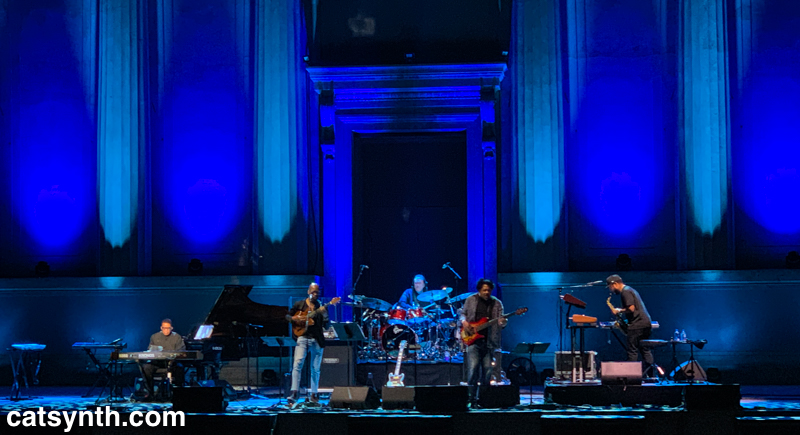
The music that I so love and admire (and try to play) but not as a museum or conservatory piece but as something dynamic and vital. He did a full rendition of Actual Proof, complete with introductory description – this piece is perhaps one of my favorites of his, in part because it is so rhythmically confounding – it is in 4/4 but the way the main riff spreads over bars, it can be hard to tell where the measures begin and end. I also enjoyed how he broke out the keytar and the vocoder from the late 1970s in several songs.
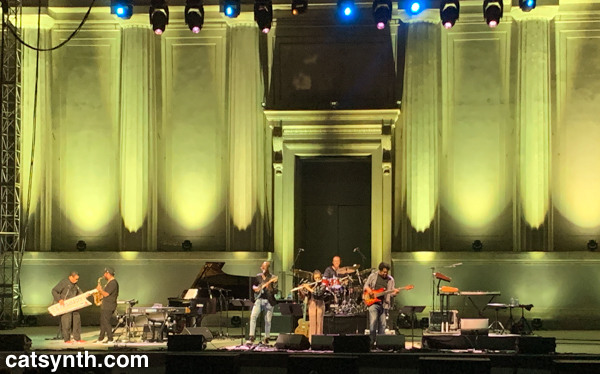
It wasn’t all updates on old favorites, as there was newer material as well. And he remains a consummate showman, giving his personal energy back to the crowd. Towards the end of the set, he led all of us in a wave while beaming from ear to ear – this then served as the introduction to a final encore jam of Chameleon where Kamasi Washington and others joined him on stage.
Kamasi Washington’s own set was also full of energy and complex music – perhaps a bit overshadowed for me by Herbie, but still a favorite of the crowd many of whom were sporting Washington’s t-shirts. He had an interesting band with two drummers (Tony Austin and Ronald Bruner Jr) and Cameron Graves on keyboard/synth. Rounding out the band was Ryan Porter on the trombone, Patrice Quinn on vocals, and Miles Mosley on bass. Perhaps the most touching moment was when Washington’s father, Rickey Washington, came out to join the band on soprano saxophone.
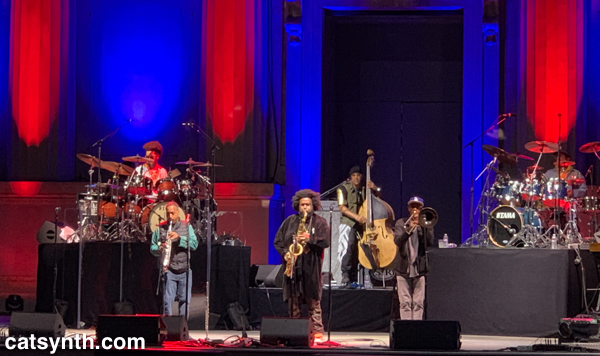
The opening set featured Robert Glasper and his band. A local favorite, his music weaved together elements of jazz with hip-hop. Centered around Glasper on keyboards, his group brought together different elements such as upright bass and turntable.
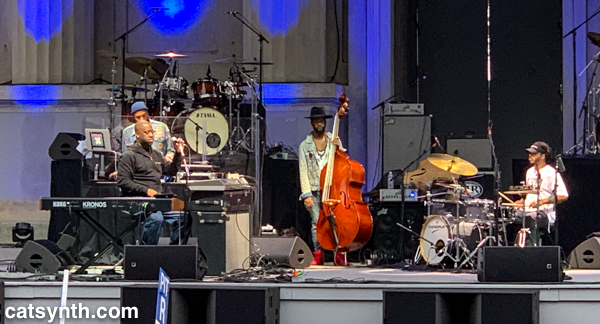
Overall, the show taken as a whole was one of the best live concerts I have seen in a while, which each group building on the foundation set by its predecessor, culminating in Herbie Hancock’s musical odyssey (there was, however, no Arp Odyssey this time). Even as an even chill settled into the Greek Theater during his set, I barely noticed. As as I practiced for my own music the coming week, I couldn’t help but notice myself doing more of those chromatically rising fast runs that are so characteristic of his solos. It’s not copying, but rather influence and tribute – a subject for another article at another time.